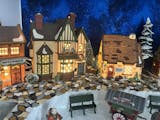Use of Embroidery Makes the Most of This Novelty Fabric
Novelty fabric is one of the pieces that grabs your attention in an instant. It might not seem suitable for making a classy tote bag or elegant purse. However, the addition of embroidery adds an edge to the whole project. Let’s have a look at novelty fabric and its uses.
Novelty Fabric
Using a novelty fabric is fun yet a little hard to work on because finding similar patterns that coordinate is a difficult task. Therefore, we move towards one tone or solid fabrics for a good match. However, this hack is not suitable for larger projects because it will show large blank spaces amongst specially printed pieces.
Examples of a Novelty Print
Toile De Jouy is one of the first examples of a novelty print fabric. The French patterns on cotton fabric show pastoral scenes and Greek mythology images. As they got famous, they started showing more historical events this way, such as Bastille Day celebrations.
Novelty prints greatly aid in commemorating a special occasion. Throughout time, these prints have been helpful in events such as elections or coronation, etc. Such prints are launched in limited quantities as special additions because they tend to lose grasp as soon as the event is over. Novelty prints mostly become collectors’ items in the later years.
Novelty fabrics are also known as conversational prints that are neither natural floral nor a proper abstract. The fabric theme features horses, places, activities, frogs, cars, sports, and many more. For example, a leopard print does not qualify as a novelty fabric but a leopard hunting its prey, is.
Why is novelty print known as a conversational print?
This fabric is so named because of its recognizable pattern usage. They are beyond regular ones and instantly become an anchor of a conversation because of familiarity hence known as a conversational print.
Directional Prints
Novelty prints are available in various fabrics, one of which is cotton. Usually, these prints are unidirectional. You must be thinking, what that means; well, a novelty print looks right from only one direction.
Sewing Tips for Sewing Using Novelty Fabrics
Novelty printed fabrics are painted may be metallic or embroidered. They do add an edge to the sewing project but also are extremely challenging to deal with while working. Here are a few pointers that will come in handy during working with this demanding piece of material.
1. Change the needle repeatedly during the project.
Sewing novelty fabric shows its effects on the needle. Constant wear and tear make the needle dull, snagging the fabric and messing up the stitches.
2. Always test wash your fabric before getting on with your sewing project.
Washing needs for the embellishments may differ from the base fabric. That is why we always suggest keeping various scraps of the material and running them through multiple kinds of washing methods. This is somewhat like a hit and trial method. Different washing methods and the fabric aftermath tells which treatment is most suitable.
3. Always use a press cloth for ironing purposes.
Muslin and silk organza press cloths have proven themselves as the most appropriate choice for press cloths. It does not make much of a difference; you can use whichever is feasible and easily available. All we want is that it acts as a layer between the iron and fabric, preventing the melting of the paint or metallic threads on the iron.
4. Using a machine foot
Different fabrics work well for different feet. However, a foot roller should be considered to make the fabric not stick or snag.
5. Make sure to check the fabric for any kind of flaw before getting on with it.
Manufacturing defects are more common in this type of fabric. Although this habit is beneficial in general, whichever material is in question for the sewing project. If you do not practice thorough screening, one unlucky day, a smudged paint can land right in the center of the jacket after you are done, making the product unfit for use.
6. Sew on a tearable steam sterilizer or a tissue paper
This is useful for preventing snagging of the metallic threads on the feed dogs. Sew the bottom layer with tissue paper or tearable steam sterilizer for prevention.
7. Do not forget to test the button holes and top stitching.
Embellished fabric sometimes causes uneven or skipped stitches that are not very much noticeable in a seam but increase frustration during the top stitching. Here’s what you can do in such a situation, if the issue is of skipping stiches, then do not topstitch or use an alternative of button holes like clasps or snaps.
How Can We Use Novelty fabrics?
It is seen that adults usually choose solids or one tone since they are safe and nothing can go wrong with them. However, there are many opportunities available in novelty fabrics that you might have missed, like Alexander Henry designs; they are fresh and unique, making them perfect for projects.
Novelty fabrics are perfect for quilting, upholstery, dresses, blouses or even face masks which are now an essential part of lives.
How to Choose a Novelty Fabric?
Lightweight fabrics are best for making dresses and similar projects, but if you plan to work on furnishing one like soft furnish, then heavy ones are suitable. These are perfect for curtains or cushions and are considered the most durable choices. As far as quilting is concerned, a medium weighing material would work.
If you have queries regarding the choice of materials from cottons to silks, canvas to embroidered, from linens to voiles, or prints, head to Royal Motif Fabrics for help. We will fix you up with the best material at most affordable prices.
- Royal Motif
